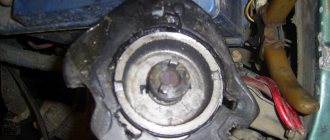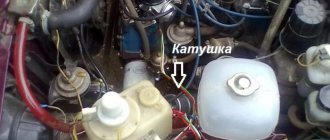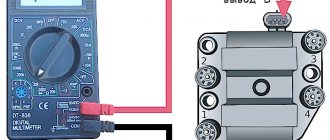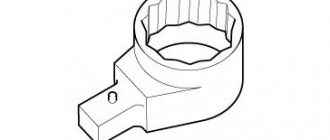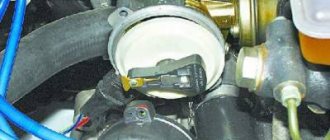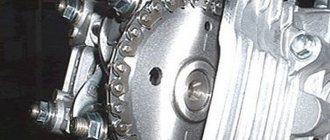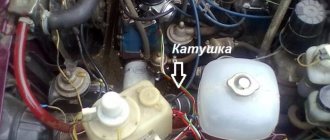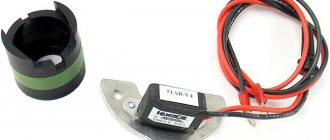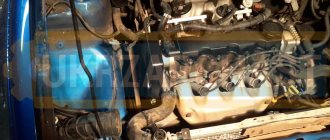Why do you need proper ignition installation?
If the torque setting is incorrect, there will be both a decrease in engine output power and increased wear of the gas distribution mechanism, increased vibration, various malfunctions, increased detonation, and increased noise. The mixture does not burn immediately, but a detonation wave appears that hits the cylinder walls, causing vibration. The figure shows the combustion chamber of a VAZ engine at the moment of top dead center, when operating pressure is created, the valve reliably closes the chamber. 1 – normal combustion zone, 2 – mixture detonation zone.
Installing the "Start" button
Some car enthusiasts install a separate button in the car in a convenient place to start the engine. It is connected to the starter circuit by breaking the red wire going to terminal 50 on the ignition switch. The car is started as follows:
In this case, you can turn off the engine only by turning the key in the opposite direction.
In order to use a button to stop the motor, that is, to turn it into a “Start-Stop” button, you need to use two additional relays:
When you press the button, current from the battery goes to the headlight relay, closing its contacts, and then to the starter. When the engine starts, the button is released, opening the contacts of the starter relay and breaking its circuit. However, the positive wire remains connected through the headlight relay for some time. When you press the button again, the headlight relay contacts open, breaking the ignition circuit, and the engine stops. To delay the activation of the starter, an additional transistor is included in the circuit.
Thus, even a novice car enthusiast can replace the ignition switch of a VAZ 2107. To do this, you need a minimum set of tools and following the recommendations of specialists
Particular attention should be paid to the correct connection of wires to the lock contacts
Source
Preparing for correct ignition setting
First you need to make sure that:
- all the spark plugs are in good working order, the gaps in them are adjusted, no carbon deposits are formed, if there is carbon deposits, then the spark plugs need to be calcined. On the left is a candle with carbon deposits, on the right is a more normal one.
- spark plug wires have good contact and insulation;
- The contacts of the distributor are not burnt. If they are burnt, you need to replace the contact group.
- the quality of the wire from the coil and the contacts are good, the insulation is normal, the ignition coil is working;
- All dust and dirt should be removed from the coil, distributor contacts, and distributor cap;
- The adjustment must be performed with the engine fully warmed up; to do this, wait until the radiator cooling fan turns on.
Now let’s talk about how you can set the ignition on a VAZ 2107. The adjustment is carried out in a simple way, using a light bulb. You can also set the ignition using a spark or strobe. The sequence of actions is as follows:
- remove the spark plug from the first cylinder;
- insert a rubber plug of a suitable size into the hole;
- then rotate the crankshaft either with a gas wrench, or with a ratchet wrench, or with a special crankshaft wrench, slowly until the plug comes out. This means the piston is at or very close to top dead center;
- after this, carefully align the marks of the crankshaft pulley and the middle mark on the front engine cover; The middle mark indicates 5° ignition advance.
- after that, remove the ratchet wrench, screw the spark plug back in and install the wire;
- prepare a 12 V light bulb, one for the ignition coil output (plus), and the second for ground;
- determine the ignition timing - loosen the distributor fastening nut with a 13mm wrench;
- turn on the ignition, the light comes on;
- turn the distributor rotor clockwise until the light goes out;
- slowly turn the distributor rotor COUNTERclockwise until the light comes on again. This reverse stroke is a fine adjustment when the torque is set correctly.
- fasten the nut.
Now you need to check whether the torque setting is correct. To do this, you need to choose a straight section of the road, without ups and downs, and with a fully warmed-up engine, we drive in 4th gear at a speed slightly lower than usual, about 50 km/h, and then sharply accelerate. A characteristic “knock of fingers” appears. After the speed increases by 5 km/h, the knocking should stop on its own. This means that the ignition timing is set correctly. If the knocking noise does not occur at all, or lasts much longer, the angle setting is insufficient and the adjustment must be repeated.
The Zhiguli “classic” VAZ 2107 does not belong to modern cars, made with the latest technology and stuffed with sophisticated electronics. This is its beauty - you don’t need to contact car service specialists for any reason; most car maintenance work can be done by the owner himself. This also includes the procedure for setting up the ignition, which anyone can do after studying the detailed instructions.
- 1 When should you turn on the ignition?
- 2 Types of systems
- 3 Preparatory stage
- 4 Settings on carburetor modifications of the VAZ 2107
- 5 Checking and adjusting the advance angle
- 6 How to set the ignition without a light bulb - video
- 7 How to set the ignition on a VAZ 2107 with an injector?
- 8 Video on checking the ignition module
Procedure for operating a car with a carburetor
To set the ignition on a VAZ 2107, you do not need to create any special conditions. Work can be performed even outside during the cold season. Here is the ignition diagram for a car with a carburetor.
The sequence of operations on machines with contact and contactless modules is approximately the same:
- Work must begin with a cold engine. First, remove the wires from the spark plugs.
- Then the candles themselves are unscrewed. It's better to remove everything, so the crankshaft will move easier.
- Now close the place of the spark plug on the 1st cylinder with your finger in order to feel when the compression stroke in the cylinder begins.
- The key turns the crankshaft until the stroke begins.
- Continuing the rotation of the crankshaft, the ignition of the VAZ 2107 carburetor is installed according to the marks.
- Now you need to unclip the latches on the tumbler and check the direction of the slider. Its outer contact should be directed to the wire of the 1st cylinder.
When should you turn on the ignition?
The first thing you should know is that there are no regulations for this operation, since the ignition timing is set or adjusted only if necessary. It may be caused by the following reasons:
- You recently purchased a “Seven” on the secondary market and are trying to “bring it to mind.”
- After engine repair, accompanied by its disassembly.
- After unscrewing or removing the main ignition distributor (distributor), regardless of the reason why this was done.
- When switching from high-octane fuel to gasoline with a lower octane number and vice versa.
- After replacing the contact group or bearing in the distributor (in cars with an old ignition system).
Note. On VAZ 2107 vehicles equipped with an electronically controlled injector, the reason for checking the spark generation system may be the flashing of the Check Engine display on the instrument panel. True, it behaves in a similar way when a dozen more malfunctions occur. So ignition problems must first be diagnosed by contacting a service station.
In the vast majority of cases, the sparking moment is set as a result of a violation of the settings after disassembling or repairing the engine. A separate issue is the transition to high-octane gasoline, which requires ignition with greater advance, for which adjustments are being made.
It is advisable to check the timely formation of a discharge on the electrodes of the spark plugs in cases where unstable engine operation is observed, popping noises are heard in the carburetor and exhaust pipe, accompanied by an increase in fuel consumption. If you have not yet discovered the “gluttony” of the car, then pay attention to the color of the smoke; with high gasoline consumption, it is black, as is the carbon deposits on the electrodes of the spark plugs.
What is ignition timing?
For the ignition to work correctly, the following condition must be met: sparking must occur at the moment when the piston is at TDC. This should be a compression stroke. This moment should be the flash point.
Do-it-yourself carburetor adjustment for VAZ 2107
| Options | Classical | Contactless | |
| Spark energy | mJ | 20 | 60 |
| Secondary voltage rise time from 2 to 15 kV | mks | 30 | 20 |
| Secondary voltage max | kV | 26 | 29,5 |
| Spark duration | ms | 1,5 | 2 |
However, that's not all. The time it takes for the fuel mixture to completely burn must also be taken into account. Therefore, the spark plugs must create an impulse with some advance, which is called the advance angle. As a result, the mixture reaches the peak of combustion, and the cylinder begins to move downward.
If sparking occurs earlier, then such ignition is called earlier, and if late, then later. Early leads to detonation. This is why the engine quickly overheats and becomes inefficient, although fuel consumption can sometimes be greatly reduced. This can be determined by the spark plug electrodes, which are covered with a white coating. With late ignition, power is noticeably lost, and black smoke comes out of the exhaust pipe, which indicates that gasoline, without having time to burn in the cylinder, burns out in the exhaust system.
The spark plugs, in this case, turn black. Popping noises in the exhaust pipe can also tell this. Late ignition means that the spark plugs are simply flooded with fuel, which does not burn or burns incompletely. When they are flooded, they do not work.
Ignition systems are divided into 3 groups:
Electronic ignition system (microprocessor ignition system)
Electronic ignition system
Pros and cons of contactless ignition
| Pros + | Minuses - |
| Current is supplied to the ignition coils through a semiconductor switch to the primary winding, this makes the spark energy much greater due to the higher voltage on the secondary winding of the ignition coil (up to 10 kV). | The most significant disadvantage of this ignition system is its low reliability compared to others. The well-known switches that were initially installed on these systems were characterized by very low reliability and often failed. |
| Functionally replacing the CG, an electromagnetic pulse shaper made using a Hall sensor and which, compared to the CG, provides a significantly better pulse shape, as well as stability, throughout the entire engine speed range. In this regard, an engine equipped with BSZ produces significantly better power indicators and allows significant savings on fuel (up to 1 liter per 100 km). | If any problems arise, you will not be able to do without new spare parts. |
| A significant advantage of this ignition system is the low need for frequent adjustments and maintenance compared to KSZ. But as for servicing the system, everything is simple and comes down to lubricating the distributor shaft every 10 thousand km. mileage |
Pros and cons of contact ignition
| Pros + | Minuses - |
| This is the simplest ignition system, it can be repaired in an open field using a spool and a match within 10 minutes; this number will not work with a contactless number. Failure of the contact ignition system is unlikely. | Current is supplied to the primary winding of the ignition coil through a contact group. In connection with this, there is a significant limitation on the voltage on the secondary winding of the coil (up to 1.5 kV), which means there is strong spark formation. |
| Maintenance is required frequently. It is necessary to constantly monitor the gap in the CG, the angle of the closed state of the CG. It is necessary to constantly clean the KG contacts because they burn during operation. Also, the distributor shaft needs to be lubricated every ten thousand kilometers. It is also recommended to lubricate the distributor cam. | |
| The reliability of this system is low; it often breaks down and requires constant maintenance. |
| Pros + | Minuses - |
| A significant advantage of the MPSZ is that it provides high-quality ignition control depending on the crankshaft speed, pressure in the intake manifold, engine temperature, and carburetor throttle position. There is no mechanics in the system, so this ignition system produces a spark perfectly, the sparking is very powerful. | Cannot be repaired in the field. Difficult to find spare parts. Low reliability. |
Types of systems
For decades, while the VAZ 2107 model was produced (from 1982 to 2012), it was equipped with three types of ignition systems:
Contact ignition circuit installed in the first VAZ 2107 models
Note. The first 2 varieties were installed on the “seven” with a carburetor, the latter was introduced together with an injector.
In the mechanical version, the contacts opened by the cam of the distributor shaft break the low voltage circuit, initiating the formation of a powerful pulse in the secondary winding of the coil. This discharge is directed to the electrodes of the spark plug, which ignites the fuel in the cylinder where the piston has risen to top dead center (TDC) and the compression stroke is completed.
Scheme of non-contact ignition of the seven with a carburetor
The contactless circuit operates on the same principle, only the signal to break the circuit is supplied by the Hall sensor, and it is implemented by the switch. Therefore, setting the ignition on carburetor “sevens” is done almost identically. Another thing is cars with an injector, where a new system has been introduced that does not have not only contacts, but also a distributor and any moving parts. Here, the moment of spark formation is determined by the ECU controller, which is guided by the signals of various sensors.
Ignition system VAZ 2107 with injector
The device of the ignition system of the VAZ 2106
The ignition system (IS) of a gasoline engine is designed to create and timely supply pulse voltage to the spark plugs.
Composition of the ignition system
The VAZ 2106 engine is equipped with a battery-contact ignition system.
VAZ 2106 cars are equipped with a battery-contact ignition system
The ignition system includes:
- accumulator battery;
- switch (ignition switch with a group of contacts);
- double-winding transforming coil;
- distributor (distributor with contact-type breaker and capacitor);
- high voltage wires;
- candles.
The ignition includes low and high voltage circuits. Low voltage circuits include:
- battery;
- switch;
- primary winding of the coil (low voltage);
- breaker with spark arresting capacitor.
The high voltage circuit includes:
- secondary winding of the coil (high voltage);
- distributor;
- spark plug;
- high voltage wires.
Purpose of the main elements of the ignition system
Each SZ element is a separate unit and performs strictly defined functions.
Accumulator battery
The battery is designed not only to ensure the operation of the starter, but also to power the low voltage circuit when starting the power unit. During engine operation, voltage is supplied to the circuit not from the battery, but from the generator.
The battery is designed to start the starter and supply power to the low voltage circuit
Switch
The switch is designed to close (open) contacts of a low-voltage circuit. When you turn the ignition key in the lock, power is supplied (cut off) to the engine.
The ignition switch closes (opens) the low voltage circuit by turning the key
Ignition coil
The coil (bobbin) is a step-up two-winding transformer. It increases the voltage of the on-board network to several tens of thousands of volts.
With the help of an ignition coil, the voltage of the on-board network is increased to several tens of thousands of volts
Distributor (distributor)
The distributor is used to distribute the pulse voltage coming from the high-voltage winding of the coil to the rotor of the device along the contacts of the top cover. This distribution is carried out by means of a slider having external contact and located on the rotor.
The distributor is designed to distribute voltage across the engine cylinders
Breaker
The breaker is part of the distributor and is designed to create electrical impulses in a low-voltage circuit. Its design is based on two contacts - stationary and movable. The latter is driven by a cam located on the distributor shaft.
The breaker design is based on moving and stationary contacts
chopper capacitor
The capacitor prevents the formation of a spark (arc) at the breaker contacts if they are in the open position. One of its outputs is connected to the moving contact, the other to the stationary one.
The capacitor prevents sparking between the open contacts of the breaker
High voltage wires
Using high-voltage wires, voltage is supplied from the terminals of the distributor cover to the spark plugs. All wires have the same design. Each of them consists of a conductive core, insulation and special caps that protect the contact connection.
High-voltage wires transmit voltage from the contacts of the distributor cap to the spark plugs
Spark plug
The VAZ 2106 engine has four cylinders, each of which has one spark plug. The main function of spark plugs is to create a powerful spark that can, at a certain moment, ignite the combustible mixture in the cylinder.
Spark plugs serve to ignite the fuel-air mixture
When you turn the ignition key, current begins to flow through the low-voltage circuit. It passes through the contacts of the breaker and enters the primary winding of the coil, where due to inductance its strength increases to a certain value. When the breaker contacts open, the current instantly drops to zero. As a result, an electromotive force arises in the high-voltage winding, increasing the voltage tens of thousands of times. At the moment such a pulse is given, the distributor rotor, moving in a circle, transmits voltage to one of the contacts of the distributor cover, from which voltage is supplied to the spark plug through a high-voltage wire.
Preparatory stage
To set the ignition on a VAZ 2107 car, no special conditions are required; the operation can be done both in the garage and on the street, including in winter. For work, prepare the following set of tools:
- flat screwdriver;
- metal probe 0.35 mm thick;
- open-end wrench size 13 mm;
- a car light bulb designed for a voltage of 12 V with wires soldered to it;
- a wrench with a long handle designed to turn the crankshaft;
- key for unscrewing spark plugs.
Ignition tuning tool
Note. Instead of a special key to rotate the crankshaft, you can use a regular open-end wrench measuring 36 mm. If you don’t have such a key, then you will have to set the marks in the old proven way: by engaging 4th gear and raising the rear wheel, turn it manually, thereby turning the crankshaft.
Ideally, it is better to have in your arsenal a device for setting the ignition on a running engine - a strobe light. It is equipped with a lamp that flashes simultaneously with the moment of spark formation in the cylinder, which allows you to see the position of the notch on the crankshaft pulley at idle speed and clearly adjust the advance angle.
This is what a strobe looks like, which is convenient for adjusting ignition timing
Important point. The ignition is set in order to ensure that the spark appears in a timely manner and the engine starts, after which additional adjustments will be required. But the latter will not bring you the desired result when there is no compression in the cylinders or problems with the carburetor make themselves felt. If these faults are not eliminated, the engine operation will remain unstable, no matter how you configure the spark generation system.
Hence the conclusion: you can set the ignition correctly at any time, but to set it well - only on a working engine and carburetor.
About their device
Before finding out the importance of the elements of the ignition system in question, it is necessary to understand their structure. Structurally, the high-voltage wire consists of the following parts:
- A conductor through which current flows.
- Insulation - rubber or silicone is used as an insulating material.
- Protective caps on both ends.
- Metal contacts.
Each element performs corresponding tasks, and at the slightest violation of integrity, it will be necessary to replace it. Armored wires cannot be repaired, since they play one of the main roles in the car’s ignition system, and also belong to the category of consumables.
This is interesting! Few people know that on a car it is necessary to change not only the spark plugs, but also the armored wires, which wear out over time and begin to malfunction.
For a distributor or MH
Read this, it might come in handy: Compressor or turbine?
It is a mistaken belief that armored wires on a car are ordinary wires that are designed to transmit current from a source to a receiver. As you know, VAZ 2107 cars were produced in two variations of the fuel supply system - carburetor and injector. Although many parts and mechanisms on the carburetor and injector are the same, this does not apply to the GDP. The carburetor VVP differs from the injection one on the VAZ 2107 in the following parameters:
- The length, on which the amount of resistance also depends. The wires on the injection unit are shorter than on the carburetor.
- Fasteners that connect to the distributor on the carburetor and the ignition module on the injector.
- The amount of GDP. There are four of them on the injector, and five on the carburetor.
- Type of caps.
Knowing the design differences, you must also understand that high voltage flows through the wire. The current comes from the distributor or MG through the wires to the spark plugs. The slightest malfunctions lead to the fact that current is not supplied to the spark plug, and a spark does not occur. If a spark does not occur, the cylinder does not work, which negatively affects the operation of the engine.
Tuning on carburetor modifications of the VAZ 2107
All old textbooks on servicing classic Zhiguli models describe a method for setting the moment of spark formation using a light bulb, although experienced motorists can easily do without it. You will understand why this happens as you read this material, but for beginners it will be useful to familiarize yourself with the old proven technique.
To correctly set the ignition of the “seven”, you need to ensure that the following conditions are met simultaneously:
- the notch on the crankshaft pulley is opposite the long mark on the timing cover;
- in this case, the round mark marked on the camshaft chain drive gear coincides with the boss on its body;
- the piston of the 4th cylinder has completed the compression stroke and is at top dead center;
- the contacts inside the distributor are open;
- The movable contact of the slider faces the fixed contact on the distributor cover, where the wire from the spark plug of the 4th cylinder is connected.
Note. On non-contact systems, at this moment the Hall sensor sends a signal to the switch to break the low voltage electrical circuit, which leads to the appearance of a high voltage pulse on the wire leading to the spark plug of the 4th cylinder.
The diagram shows what happens in the cylinders when the marks are aligned
The light bulb is used to control the ignition timing, for which it must be connected with one wire to the “K” contact of the high-voltage coil, and with the second to the vehicle ground. You should know that at the same moment the piston of the first cylinder is also in the TDC position, only there the air-fuel mixture is not compressed, but exhaust gases are released after its combustion. This is why ignorant car enthusiasts often confuse the first cylinder with the fourth when installing the ignition.
Layout of marks on the timing cover
When the above actions occur simultaneously, a spark discharge occurs on the electrodes of the spark plug of the 4th cylinder, as evidenced by the flash of the connected light bulb. To achieve these conditions and set the ignition correctly, follow the instructions:
The marks must be aligned by turning the crankshaft with a wrench
Note. The instructions imply that before starting work the distributor was removed from the engine without aligning the marks.
The ignition is considered to be set correctly if, after installing the distributor cap and connecting the wires, you manage to start the engine, and then you need to adjust the timing. The non-contact system is installed in the same way, with the exception of checking the gap in the contact group due to its absence.
The mark on the camshaft gear is aligned with the boss on the body
Prerequisites for failure
In situations where there is a malfunction, VAZ 2107 owners replace the spark plugs. Old factory spark plugs are usually replaced with iridium spark plugs from NGK or Denzo. Do not forget that only those spark plugs that are designed for the appropriate type of injection are suitable here.
The type of ignition system is no less important in determining the parameters of the spark plug. Often such manipulation does not provide much improvement (plugs have a fairly long service life), so the non-contact ignition system undergoes a full diagnosis.
Diagnostics of how the ignition module and each individual coil operates is carried out using a special device called a multimeter or ohmmeter. Its functional task is to show the voltage value supplied by the ignition module. As a result of diagnostics, it is possible to identify the source of current loss in the circuit and, accordingly, the nature of the malfunction. To facilitate painstaking work, it is recommended to dismantle the module outward before starting the process.
Non-contact ignition system checks for short circuits
First, pay attention to the coil winding. To get started, connect a multimeter, which determines the resistance value
There is a recommendation regarding the lubrication of the tip of a high-voltage wire: a special product for the VAZ 2107 or technical petroleum jelly is used here.
- the module is disconnected from the tips;
- one terminal of the device is connected to the central contact, which has a coil;
- the other terminal of the device is connected to ground.
The process of checking the secondary windings of the module includes:
Here we focus on an indicator whose value will be no less than 7 ohms. Recommendation: if at least one coil does not meet the specified indicator, the module as a whole must be replaced, otherwise it will not be possible to avoid a malfunction of the system with a VAZ 2107, where an injector is used.
The ignition coil of the VAZ 2107 is located in the engine compartment on the left side of the engine and is secured to the body with two nuts. The ignition coil is an independent element of the vehicle's electrical equipment that converts low voltage current into high voltage current up to 10-20 kV, which should be sufficient to break the gap on the spark plugs and sufficient to ignite the combustible mass. The coil is non-separable, which means that if it fails, it cannot be repaired and must be replaced with a new one.
The ignition coil is a transformer consisting of an internal magnetic circuit, primary and secondary windings, as well as an external magnetic circuit connected to the ignition distributor.
To remove the coil you will need a ten and eight wrench, also disconnect the battery.
- Disconnect the central magnetic circuit from the coil.
- Unscrew the two nuts securing the power wires with a wrench.
- Using a ten-socket wrench, unscrew the two nuts securing the coil to the car body, remove the ground wire and remove the coil from the studs.
At this point, work on removing the ignition coil of the VAZ 2107 is completed. Before replacing it with a new one, you need to make sure that it is not working; for this you will need a multimeter. Before checking, thoroughly clean the primary winding leads on the coil body (two studs to which the power wires are attached) from dirt and oxides.
- First, let's check the resistance of the primary winding. To do this, connect the ohmmeter terminals to the terminals of the primary winding (two pins on the body) and take measurements. Depending on the type of coil being tested, the resistance should be: B-117A = 3-3.5 Ohm; 27.3705 = 0.45-0.5 Ohm.
- Now we check the resistance in the secondary winding circuit. To do this, we connect one ohmmeter probe to the terminal of the high-voltage wire, and leave the second at the terminal of the primary winding. The resistance should be equal: B-117A = 7.4-9.2 kOhm; 27.3705 = 5-0.5 kOhm.
At this point, the repair work on removing and checking the ignition coil of the VAZ 2107 is completed. If, after checking, deviations from the norm are found, it is recommended to replace the coil with a new one.
Checking and adjusting the lead angle
To check whether the ignition is set correctly, just align the marks on the crankshaft pulley and the timing cover. In this case, the slider should be directed to the 4th cylinder, and the contacts should be open. If the slider “looks” towards the first cylinder and the car does not start, then turn it 180° as described above.
To create optimal fuel combustion conditions in the chamber, the flash should occur a little earlier than the piston reaches TDC. There are 3 ways to achieve this:
- when installing the ignition, align the notch on the pulley not with the first long mark, but with the second, indicating an advance angle of 5°;
- determine the amount of advance “by ear” by loosening the nut securing the distributor and turning it by the housing at idle engine speed;
- connect a strobe light to the system, start the engine and by turning the distributor, adjust the position of the notch by pointing the flashing lamp of the device at it.
The advance angle is adjusted by turning the distributor housing
Reference. The second method is most often used by experienced drivers, since it gives a positive result without any instruments. The ignition distributor is turned until the position of the most stable engine operation is found. That is why the use of a light bulb does not play a big role, because the real advance angle at which the engine operates in optimal mode lies in the range of 5-10° and is determined individually in each car experimentally.
Once the settings are complete, press the gas pedal sharply several times. If you can hear the piston pins knocking (a ringing sound is clearly audible from the engine), then the advance angle is too large. Loosen the distributor and turn it 1-2° clockwise, then check again by pressing the accelerator.
Advice. Finger tapping is often heard when you fill with low octane fuel. Then it is necessary to reduce the advance angle so that detonation (which causes knocking) does not destroy the piston group. When using high-quality fuel, the angle should be increased in order to improve the dynamic characteristics of the VAZ 2107.
Ignition adjustment in static position:
- Find a strobe light. If this is not the case, do the work by ear.
- Loosen the nut holding the ignition coil.
- Start the engine and warm it up.
- Rotate the distributor housing left and right.
- Command your assistant to watch the speed (they should be at 2000 rpm).
- Listen to the engine noise. Try to catch the moments when there are “dips” or changes in rotation speed.
- Achieve a situation where the engine runs smoothly and produces the highest speed. In this case, the work should be as rhythmic as possible.
- Tighten the distributor nut and operate the car.
Setting the ignition timing of the VAZ-2107 in motion:
Remember that adjusting the advance angle may not be enough - often the carburetor itself needs to be adjusted. To do this, find a couple of screws. With one of them you regulate quality, and with the other you regulate quantity. Also clean the carburetor from time to time.
As can be seen from the described technique, setting up electronic ignition on the “seven” is not difficult. At the same time, you can count on serious savings, because at the service station this service will cost a considerable amount.
How to set the ignition on a VAZ 2107 with an injector?
The ignition system of the “Seven” with direct fuel injection operates under the control of an ECU that receives signals from the following sensors:
- crankshaft position;
- air flow;
- throttle position;
- lambda probe.
Multimeter for checking the ignition module
Based on the readings of these sensors, the controller itself determines the moment of spark formation, so the system is not configured in the usual sense. If any problems occur, the driver can only independently check the functionality of the ignition module, to which the high voltage wires from the cylinders are connected. To do this, you need to take a multimeter (ohmmeter) and perform the following steps:
The seven with an injector has an ignition module, which you can check yourself
Diagram, procedure for connecting VAZ high-voltage wires.
First, let's decide which of the four cylinders is first?
The first cylinder in front-wheel drive VAZs is located closer to the timing belt. If you look at the engine from the front, the first cylinder is the leftmost). And then everything is simple - from left to right - 1, 2, 3, 4.
In rear-wheel drive VAZ Classic and Niva, the first cylinder is located closer to the front bumper of the car.
Common malfunctions of high-voltage wires
Replacement of high-voltage wires on cars must be done not only when signs of their malfunction appear, but also regularly at the appropriate mileage, which depends on the quality of the products used. If malfunctions occur in the ignition system, then the causes of their occurrence may be GDP. Common malfunctions of armored wires on the seven include:
On a candle
- Violation of insulation integrity. The slightest cracks, scratches, cuts, etc. entail the need to replace products. If the insulation is broken, moisture gets into the conductor, the resistance increases, and the current decreases. The slightest scratches and cracks require immediate replacement of all conductors.
- Increasing resistance - wires have a corresponding resistance, which increases over time due to the deterioration of the cores. The greater the resistance, the less the amount of current flowing, and therefore the worse the spark created by the spark plug.
- Damage to contacts. This is due to oxidation that occurs inside the caps placed on the spark plugs or inserted into the distributor or ignition module. Oxides contribute to increased resistance, so they should be cleaned. If oxides are not removed in a timely manner, the metal contacts begin to deteriorate.
If at least one product malfunctions, it is necessary to perform a comprehensive replacement. In order to make sure that it is necessary to replace the armored wires on the seven, you will need to check them first. How to check the serviceability and suitability of the GDP is carried out, we will find out further.
Video on checking the ignition module
It is important to set the ignition correctly after disassembling the power unit or removing the distributor without fixing the marks, otherwise you will not be able to start the car. This task is quite simple and does not require any deep knowledge or special tools. The main thing is to understand that a spark should appear in the 4th cylinder during the compression stroke and to catch this moment, acting according to the instructions.
Annotation on setting up the ignition system of the VAZ 2107 with your own hands
The Zhiguli “classic” VAZ 2107 does not belong to modern cars, manufactured with the latest technology and stuffed with sophisticated electronics. This is its beauty - there is no need to contact car service specialists for any reason; most of the car maintenance work can be done by the owner himself. This also includes the procedure for the ignition option, which anyone can perform, having previously studied the detailed instructions.
Types of ignition timing
Acceleration dynamics, fuel consumption, trouble-free engine starting and exhaust toxicity of carburetor VAZ 2107 directly depend on correctly installed ignition. If the ignition system (IZ) of newer injection models does not require special adjustments, then cars with an older contact system require periodic adjustment.
- We accelerate the car to 40 km/h.
- We sharply press the accelerator pedal and listen to the sound of the engine.
- If noise appears and disappears when the speed increases to 60 km/h, then there is no need to adjust the SZ.
- If the noise and detonation do not disappear as the speed increases, then the ignition is early and requires adjustment.
If the ignition timing is set incorrectly, fuel consumption will increase and engine power will decrease. In addition, a number of other problems will arise - an incorrectly installed ignition will reduce the service life of the power unit.
If a spark forms on the spark plug earlier than expected, the expanding gases will begin to counteract the piston rising to the top position. In this case, they talk about early ignition. Due to too early ignition, the rising piston will expend more effort to compress the resulting gases.
This will lead to an increase in load not only on the crank mechanism, but also on the cylinder-piston group. If a spark appears after the piston passes the top dead center, then the energy generated from the combustion of the mixture enters the exhaust without performing any useful work. In this situation they say that the ignition is late.
The ignition system consists of the following elements: 1 - spark plugs; 2 — ignition distributor; 3 - capacitor; 4 — breaker cam; 5 - ignition coil; 6 — mounting block; 7 - ignition relay; 8 — ignition switch; A - to terminal “30” of the generator
To adjust the ignition of the VAZ 2107 you will need:
- key to 13;
- screwdriver;
- spark plug key;
- special key for crankshaft;
- vol (12V lamp).
- a ringing “metallic” sound has appeared in the engine operation, it is called “knock of fingers” when driving a car without load and acceleration;
- detonation, the car shakes for several seconds after the engine is turned off;
- Late ignition, retarded - a spark is formed in the cylinder after the piston passes the top dead center.
- Early, advanced - in this case, a spark is formed even before the piston appears at top dead center. With early ignition, the connecting rod and piston are faster, because the load on these components increases and carbon deposits appear.
When should you turn on the ignition?
The first thing you need to know is that there are no regulations for this operation, since the ignition timing is set or adjusted only as needed. It may be caused by the following reasons:
- You recently acquired a “seven” on the secondary market and are trying to “bring it to mind.”
- After repairing the engine, which included disassembling it.
- After unscrewing or removing the head ignition distributor (distributor), regardless of the reason why it was made.
- When switching from high-octane fuel to gasoline with a lower octane number and vice versa.
- After replacing the contact group or bearing in the distributor (in cars with an old ignition system).
Note. On VAZ 2107 vehicles equipped with an electronically controlled injector, a prerequisite for checking the spark generation system can be the flashing of the Check Engine display on the instrument panel. True, it behaves in a similar way when a dozen more malfunctions occur. So ignition problems must first be diagnosed by contacting a service station.
In the vast majority of cases, set as a result of a violation of the settings after disassembling or repairing the engine. A separate issue is the transition to high-octane gasoline, which requires ignition with greater advance, for which adjustments are being made.
It is advisable to check the timely formation of a discharge on the electrodes of the spark plugs in cases where unstable engine operation is observed, popping noises are heard in the carburetor and exhaust pipe, accompanied by an increase in fuel consumption. If you have not yet discovered the “gluttony” of the car, then pay attention to the color of the smoke; with high gasoline consumption, it is black, as is the carbon deposits on the electrodes of the spark plugs.
Design and principle of operation of the BZ
Contactless or electronic ignition on the VAZ 2107 is installed on models with injection engines. Carburetor sevens were supplied from the factory with contact ignition systems, which have many disadvantages. If you plan to install a contactless ignition module, then before starting it won’t hurt to understand the issue of its design.
The ignition system is the mechanism by which a pulsed voltage is created to supply the spark plugs in order to promptly ignite the fuel-air mixture in the cylinders. The main disadvantage of contact SZ is that the contact groups require regular cleaning, replacement and adjustment. As soon as difficulties arose with igniting the combustible mixture, the car owner immediately knew where to look for the reasons.
With the advent of the BSZ, these difficulties automatically disappeared. To understand why, let’s look at the components of the mechanism:
- Electronic type switch with transistors.
- Double winding coil.
- A distributor or distributor equipped with a Hall sensor, a slider and a contact cover.
- Spark plugs with armored wires.
The BSZ diagram for the VAZ 2107 is shown in the photo below.
Ignition circuit for VAZ 2107
Based on this diagram, let's consider the principle of its operation:
- When you turn the ignition key, current is supplied to the primary winding of the coil, thereby creating a magnetic field.
- When the engine starts, power is supplied to the starter coil and the rotor begins to turn the crankshaft.
- In this case, the crankshaft rotates the distributor shaft, which is connected to the runner.
- As soon as the shaft with the slider rotates, this phenomenon is detected by the Hall sensor (along the protrusion on the shaft) and transmits the corresponding signal to the switch.
- When a signal arrives at the switch, the primary winding of the coil is de-energized (on the low-voltage side).
- A powerful discharge of about 25-30 kV is induced in the secondary (high-voltage) winding, transmitted to a moving contact located at the end of the distributor shaft.
- When the slider moves in a circle, it practically touches the contacts in the cover, a spark occurs between them, and a high voltage discharge is transmitted to each of the contacts in turn.
- This discharge flows through armored cables to the spark plug electrodes.
Pros and cons of the system
If you decide to install a carburetor-type BSZ on a VAZ 2107, then it is recommended that you first understand all the advantages and disadvantages of the device. The advantages of the mechanism under consideration include:
- The absence of contacts automatically eliminates the need for their maintenance. As a result, we have a more reliable system that does not require frequent maintenance.
- Stability of spark propagation through the cylinders, which is due to the absence of the breaking effect of the contacts using the cam method.
- A large discharge in the spark plug, the value of which reaches 25-30 kV, while in contact modules it does not exceed 12 kV. High voltage promotes a stronger spark and improved ignition of the fuel assembly, as well as its complete combustion.
- Simplified engine starting at low temperatures.
Types of systems
For decades, while the VAZ 2107 model was produced (from 1982 to 2012), it was equipped with three types of ignition systems:
- mechanical with contacts - breakers;
- contactless;
- controlled by an electronic unit (ECU).
Note. The first 2 varieties were installed on the “seven” with a carburetor, the latter was introduced together with an injector.
See:
In the mechanical version, the contacts opened by the cam of the distributor shaft break the low voltage circuit, initiating the formation of a powerful pulse in the secondary winding of the coil. This discharge is directed to the electrodes of the spark plug, which ignites the fuel in the cylinder where the piston has risen to top dead center (TDC) and the compression stroke is completed.
The contactless circuit operates on the same principle, only the signal to break the circuit is supplied by the Hall sensor, and it is implemented by the switch. Therefore, setting the ignition on carburetor “sevens” is done almost identically. Another thing is cars with an injector, where a new system has been introduced that does not have not only contacts, but also a distributor and any moving parts. Here, the moment of spark formation is determined by the ECU controller, which is guided by the signals of various sensors.
Selecting an electronic ignition kit
Since the “sixes” were equipped with three types of engines (volume 1.3, 1.5 and 1.6 liters), the BSZ kits for them differ in the design of the distributor. The engine has 1.3 liters. (model VAZ 21063) there is a distributor with a shortened shaft, and in 1.5 and 1.6 liter engines. (VAZ 21061 and 2106, respectively) this shaft is equally long. The electronic ignition kit contains the following:
- distributor with catalog number 38.3706–01 for a 1.3 liter power unit. or 38.37061 - for 1.5 and 1.6 liter engines;
- high voltage coil marked 27.3705;
- electronic control unit, marking - 36.3734 or 3620.3734;
- connecting wires.
Kit for installing contactless ignition
Of the manufacturers selling their ignition kits in the Russian Federation, the most popular among motorists are spare parts from the SOATE company from Stary Oskol. It is worth noting that the new spark plugs of the A-17DVR brand, installed on classic VAZs with electronics, are not included in the delivery package; they will have to be purchased separately. To experience the full results of the replacement, it is also recommended to install new high-voltage wires if you have not replaced them in the recent past.
Preparatory stage
To set the ignition on a VAZ 2107 , no special conditions are required; the operation can be done both in the garage and on the street, including in winter. For work, prepare the following set of tools:
- flat screwdriver;
- metal probe 0.35 mm thick;
- open-end wrench size 13 mm;
- a car light bulb designed for a voltage of 12 V with wires soldered to it;
- a wrench with a long handle designed to turn the crankshaft;
- key for unscrewing spark plugs.
Note. Instead of a special key to rotate the crankshaft, you can use a regular open-end wrench measuring 36 mm. If you don’t have such a key, then you will have to set the marks in the old proven way: by engaging 4th gear and raising the rear wheel, turn it manually, thereby turning the crankshaft.
Ideally, it is better to have in your arsenal a device for setting the ignition on a running engine - a strobe light. It is equipped with a lamp that flashes simultaneously with the moment of spark formation in the cylinder, which allows you to see the position of the notch on the crankshaft pulley at idle speed and clearly adjust the advance angle.
Important point. The ignition is set in order to ensure that the spark appears in a timely manner and the engine starts, after which additional adjustments will be required. But the latter will not bring you the desired result when there is no compression in the cylinders or problems with the carburetor make themselves felt. If these faults are not eliminated, the engine operation will remain unstable, no matter how you configure the spark generation system.
Hence the conclusion: you can set the ignition correctly at any time, but to set it well - only on a working engine and carburetor.
ICE theory: Motor 2103 with head 21214 with reg. star (modern)
2:17 — How to measure compression 9:55 — How to install an adjustable sprocket 10:00 — How to set up a split gear.
VAZ 2107 injector - treatment of tripping and misfires
Diagnostics revealed that the fourth gasoline injector was clogged, tripping and multiple misfires in all.
Replacing the starter relay
Another common problem on VAZ 2107s with a carburetor is a malfunction of the starter relay. When you turn the key in the lock, the system makes a click, but the retractor relay does not operate. Replacing the relay is very simple.
First you need to remove the starter from the relay. Unscrew the 2 bolts that secure it. Slide it to the right and take it out, turning it backwards. Unscrew the nuts securing the starter and relay.
Turn it to the side.
Remove the 2 bolts securing the relay to the starter.
Install the new one in reverse order.
If you follow these simple steps, your VAZ 2107, which has a carburetor system, will serve you for many more years.
